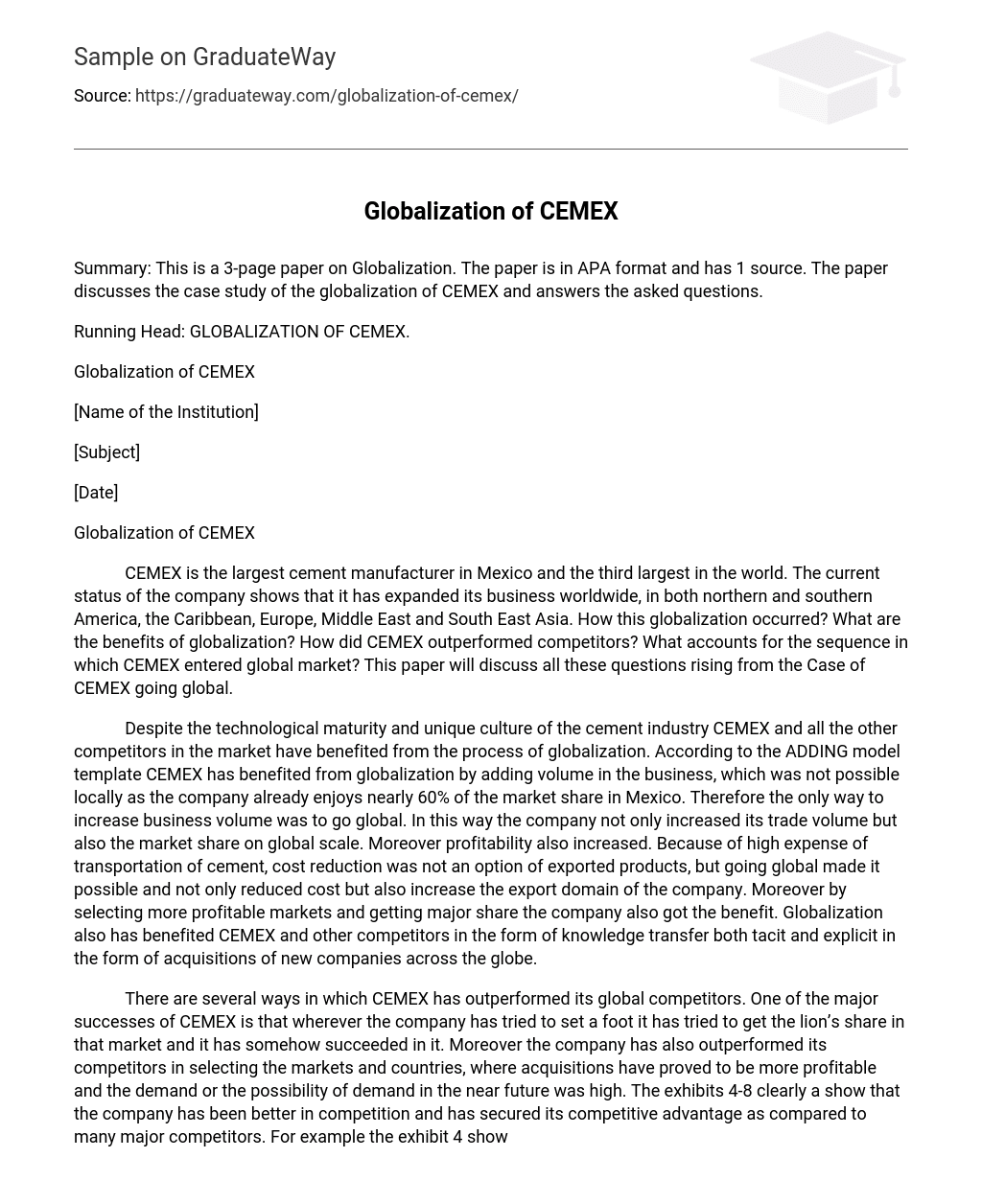Summary: This is a 3-page paper on Globalization.
The paper is in APA format and has 1 source. The paper discusses the case study of the globalization of CEMEX and answers the asked questions. Running Head: GLOBALIZATION OF CEMEX. Globalization of CEMEX [Name of the Institution] [Subject] [Date] Globalization of CEMEX CEMEX is the largest cement manufacturer in Mexico and the third largest in the world.
The current status of the company shows that it has expanded its business worldwide, in both northern and southern America, the Caribbean, Europe, Middle East and South East Asia. How this globalization occurred? What are the benefits of globalization? How did CEMEX outperformed competitors? What accounts for the sequence in which CEMEX entered global market? This paper will discuss all these questions rising from the Case of CEMEX going global. Despite the technological maturity and unique culture of the cement industry CEMEX and all the other competitors in the market have benefited from the process of globalization. According to the ADDING model template CEMEX has benefited from globalization by adding volume in the business, which was not possible locally as the company already enjoys nearly 60% of the market share in Mexico. Therefore the only way to increase business volume was to go global. In this way the company not only increased its trade volume but also the market share on global scale.
Moreover profitability also increased. Because of high expense of transportation of cement, cost reduction was not an option of exported products, but going global made it possible and not only reduced cost but also increase the export domain of the company. Moreover by selecting more profitable markets and getting major share the company also got the benefit. Globalization also has benefited CEMEX and other competitors in the form of knowledge transfer both tacit and explicit in the form of acquisitions of new companies across the globe.
There are several ways in which CEMEX has outperformed its global competitors. One of the major successes of CEMEX is that wherever the company has tried to set a foot it has tried to get the lion’s share in that market and it has somehow succeeded in it. Moreover the company has also outperformed its competitors in selecting the markets and countries, where acquisitions have proved to be more profitable and the demand or the possibility of demand in the near future was high. The exhibits 4-8 clearly a show that the company has been better in competition and has secured its competitive advantage as compared to many major competitors. For example the exhibit 4 shows that CEMEX has CEMEX’s sales, volume of cement, EBIT, EBITDA, Cash flow, market value and profitability of stock all are higher when compared to the other major competitors. The exhibit 5 depicts the capacity of the major competitors in the global market and it clearly shows that CEMEX has dominated in those markets where the demand is higher or there is a potential of high demand in the near future, particularly in the Asia-Pacific, Middle East and Latin American region.
Exhibit 7 shows the statistics of the markets, which clearly depicts that the strongholds of CEMEX are all high demand markets. The global expansion of CEMEX, when studies with reference to the CAGE model, clearly exhibits how diligent and careful the executives of the company had been while planning there early entry in the global market. The first acquisition of CEMEX was in the United States. Here the geographical, economical cultural distances were easy to overcome as the southern United States has a Spanish speaking population and geographically the closest country for CEMEX. After the United States the next major expansion took place in Spain.
Spain had been the mother country for the Mexicans since the time of colonization. Here the cultural, administrative and economical distances where negligible. Latin American was the next phase where cultural, and geographical barriers were easy to overcome and large demand of cement was also a main economic factor. Middle East and Asia-Pacific were the later expansion targets when the company had enough experience and expertise in the normalization and standardization of all the newly acquired units. This would have made it easy for CEMEX to overcome all the CAGE barriers in these regions.
Speaking about the future strategy of CEMEX regarding global expansion, I would like to recommend the South Asian and South East Asian region for further expansion. This recommendation is based on the fact that this region includes the most rapidly growing economies, like India and China, the most populous countries in the world. The economic boom has led to the mass construction in every sector therefore there is always going to be a high demand of cement in the 21st century. Moreover speaking about he way these global expansions should be done, I think that the most viable method is mergers and acquisitions.
This is because it is easier and cost effective than constructing and installing a new plant there. This also requires hiring and training all the labor for the plant from the scratch. Therefore it is more troublesome to build a new plant in a new country as compared to acquiring and running an already running local company. Though constructing a new plant is also feasible in some locations, particularly China, where many U.S. and European companies have established there own plants and production units.
References: Ghemawat, P. (2000). The globalization of CEMEX (Case No. 9-701-017). Boston: Harvard Business School Press.
Ghemawat, P. (2001, September). Distance still matters: The hard reality of global expansion. Harvard Business Review, 79(8), 137-147.





